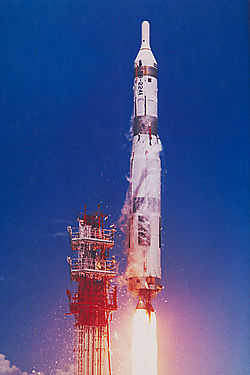850th Strategic Missile Squadron
| 850th Strategic Missile Squadron | |
|---|---|
 First successful launch of an SM-68 Titan I ICBM at Cape Canaveral, Florida on 10 August 1960 at the Atlantic Missile Range | |
| Active | 1943–2945; 1960–1965 |
| Country | United States |
| Branch | |
| Type | Squadron |
| Role | Intercontinental ballistic missile |
| Engagements | World War II (EAME Theater) |
| Decorations | French Croix De Guerre (with Palm) |
| Insignia | |
| 850th Strategic Missile Squadron emblem |  |
The 850th Strategic Missile Squadron (850 SMS) is an inactive United States Air Force unit. It was last assigned to the 44th Strategic Missile Wing, stationed at Ellsworth Air Force Base, South Dakota.
The 850 SMS was equipped with the HGM-25A Titan I Intercontinental ballistic missile (ICBM), with a mission of nuclear deterrence. The squadron was inactivated as part of the phaseout of the Titan I ICBM on 25 March 1965.
History
World War II
Established as a B-24 Liberator heavy bomber squadron in mid-1943; trained under Second Air Force in the northwestern United States. Deployed to European Theater of Operations (ETO) in April 1944; being diverted to VIII Composite Command and attached to a provisional special operations unit in England.
Used long-range B-24s to carry out special operations missions; dropping personnel and supplies to the resistance forces in occupied France, Belgium, the Netherlands, Denmark, and Norway.
Relieved from clandestine operations in August 1944 and rejoined former heavy bomber group and re-equipped with B-17 Flying Fortresses. Engaged in strategic bombardment raids over Occupied Europe and Nazi Germany, attacking enemy military and industrial targets until the German capitulation in May 1945.
Most of squadron personnel demobilized in Europe, small cadre of personnel returned B-17s to the United States and reformed as a unit in Florida. Programmed for conversion to a B-29 Superfortress heavy bombardment squadron and deployment to Central Pacific Area (CPA) for strategic bombardment raids over the Japanese Home Islands; however never re-equipped and was inactivated after the Japanese Capitulation in November 1945.
Intercontinental Ballistic Missile Squadron
Reactivated in 1960 as a HGM-25A Titan I ICBM launch squadron. Squadron was deployed in a 3x3 configuration, which meant a total of nine missiles were divided into three bases. Each missile base had three ICBM missiles ready to launch at any given time. Reassigned from the 28th Bombardment Wing to the newly established 44th Strategic Missile Wing at Ellsworth on 1 January 1962, making the 28th BMW a fully B-52 Stratofortress organization.
On 19 November 1964, Defense Secretary McNamara announced the phase-out of remaining first-generation SM-65 Atlas and Titan I missiles by the end of June 1965. Consequently, the Titan Is of the 850th SMS were removed from alert status on 4 January 1965. The last missile was shipped out on 12 February. The Air Force subsequently inactivated the squadron on 25 March.
Missile sites were later sold off to private ownership after demilitarization. Today the remains of the sites are still visible in aerial imagery, in various states of use or abandonment.
Lineage
- Constituted 850th Bombardment Squadron (Heavy) on 14 September 1943
- Activated on 1 October 1943
- Inactivated on 7 November 1945
- Re-designated 850th Strategic Missile Squadron, and activated, on 22 June 1960
- Inactivated on 25 March 1965.
Assignments
- 490th Bombardment Group, 1 October 1943
- VIII Air Force Composite Command, 11 May 1944
- Attached to 801st Bombardment Group (Provisional), 22 May-10 August 1944
- 490th Bombardment Group, 10 August 1944 – 7 November 1945
- Strategic Air Command, 22 June 1960
- 28th Bombardment Wing, 1 December 1960
- 44th Strategic Missile Wing, 1 January 1962 – 25 March 1965
Stations
- Salt Lake City AAB, Utah, 1 October 1943
- Mountain Home AAF, Idaho, 4 December 1943 – 9 April 1944
- RAF Harrington (AAF-179), England, 27 April 1944
- RAF Cheddington (AAF-113), England, 11 May 1944
- RAF Harrington (AAF-179), England, 27 May 1944
- RAF Eye, England (AAF-138), 12 August 1944-c. 26 August 1945
- Drew Field, Florida, 3 September-7 November 1945
- Ellsworth AFB, South Dakota, 1 December 1960 – 25 March 1965,
Aircraft and missiles

- B-24 Liberator, 1943–1944
- B-17 Flying Fortress, 1944–1945
- HGM-25A Titan I, 1960–1965
- Operated three missile sites: (1 December 1960 – 25 March 1965)
- 850-A, 4 miles NNW of Wicksville, South Dakota 44°08′10″N 102°37′02″W / 44.13611°N 102.61722°W
- 850-B, 5 miles SSE of Hermosa, South Dakota 43°46′34″N 103°08′46″W / 43.77611°N 103.14611°W
- 850-C, 10 miles SE of Sturgis, South Dakota 44°23′51″N 103°18′48″W / 44.39750°N 103.31333°W
See also
References
![]() This article incorporates public domain material from the Air Force Historical Research Agency
This article incorporates public domain material from the Air Force Historical Research Agency
- Maurer, Maurer, ed. (1982) [1969]. Combat Squadrons of the Air Force, World War II (PDF) (reprint ed.). Washington, DC: Office of Air Force History. ISBN 0-405-12194-6. LCCN 70605402. OCLC 72556.


